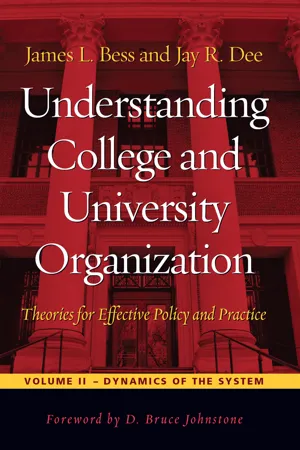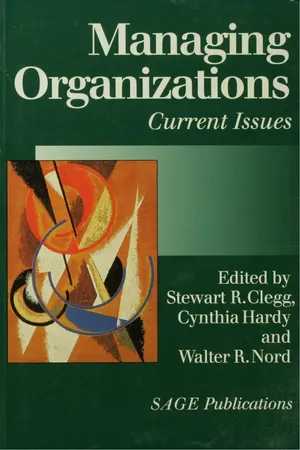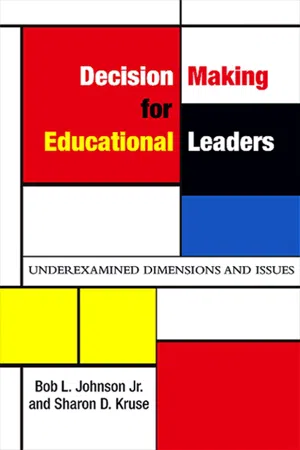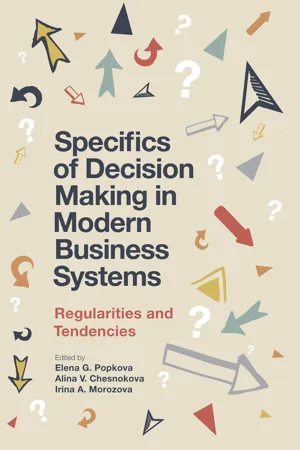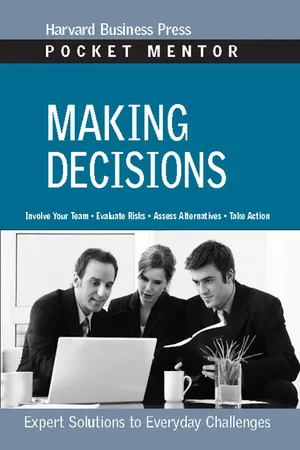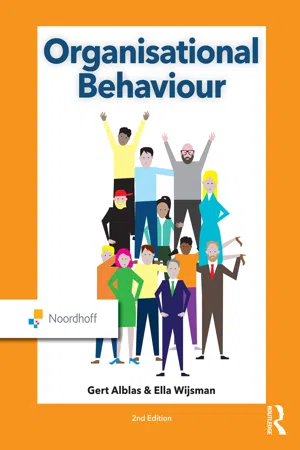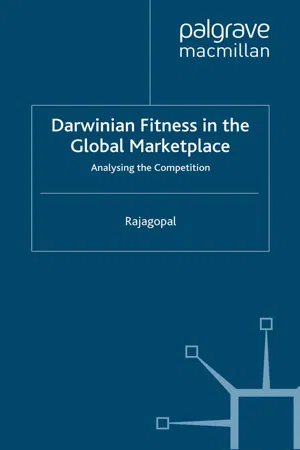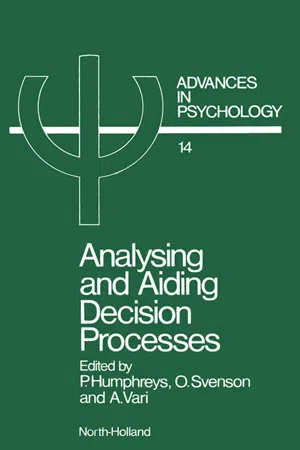Business
Organizational Decision Making
Organizational decision making refers to the process by which businesses make choices and take action. It involves gathering information, analyzing options, and selecting the best course of action to achieve the company's goals. Effective decision making is crucial for the success and growth of a business, as it impacts various aspects such as operations, finances, and overall performance.
Written by Perlego with AI-assistance
Related key terms
1 of 5
10 Key excerpts on "Organizational Decision Making"
- eBook - ePub
Understanding College and University Organization
Theories for Effective Policy and Practice: Volume II — Dynamics of the System
- James L. Bess, Jay R. Dee(Authors)
- 2023(Publication Date)
- Routledge(Publisher)
4 Organizational Decision Making CONTENTS- Preview
- Case Context
- Introduction
- Decision Making as a Process
- Decision Making as Structure
- Participation Theories
- Risky Shift, Polarization, and Social Loafing in Group Decision Making
- Social Constructionist Perspectives on Group Decision Making
- Summary
- Review Questions
- Case Discussion Questions
- References
The authors are most grateful for the critical comments on an early draft of this chapter by Jason Lane, University of North Dakota. The final version, of course, is our own and may or may not reflect the perspective of the reviewer.Preview- Decisions in organizations are typically either routine or require individual or group judgments about novel circumstances.
- All decisions have implicit value assumptions.
- Decisions are the result of the application of rationality, but they are modulated by considerations of risk and individual personality.
- Organizations tend to program as many decisions as possible, since such procedures are efficient in the short run.
- Because it is impossible for workers to know all of the relevant information needed for a decision, they tend to satisfice.
- A typical sequence of steps in the decision process includes decision recognition, diagnosis, development of solutions, selection, screening, evaluation and choice, and authorization.
- Organizational decisions can be classified as strategic, tactical, or operational. They vary on a variety of dimensions.
- eBook - PDF
Managing Organizations
Current Issues
- Stewart R Clegg, Cynthia Hardy, Walter R Nord, Stewart R Clegg, Cynthia Hardy, Walter R Nord(Authors)
- 1999(Publication Date)
- SAGE Publications Ltd(Publisher)
3 Decision-Making in Organizations S U S A N 1 . M I L L E R , D A V I D 1 . H I C K S O N A N D D A V I D C . W I L S O N The area of organizational decision-making is part of the broader field of organization studies and organization theory. It has therefore followed a similar pattern of evolution, drawing on a variety of paradigms and perspectives and being characterized by a multiplicity of theories, models and methodologies. This chapter charts its development as a subject of study. The chapter attempts to show how competing views and alternative theoretical frameworks of the way in which decisions are made have shaped both the methods of enquiry and subsequent explanations. The central con-cepts of rationality and power in decision-making are discussed. Further, the understand-ing of decision-making as an organizational process is explored in detail, as is the relatively neglected area of implementation. Decision-making overlaps other areas, notably strategic management, so the ways in which strategic decisions and strategies may be related are addressed. Finally, the chapter recognizes that most work on decision-making implicitly assumes culturally bounded Western views of the world and its management processes. WHY DECISION-MAKING? Why should decision-making be studied at all? Although its popularity has waxed and waned over time it has continually stayed on the stage of organizational debate, though not always in the spotlight. Why should this be so? There are a number of reasons. Certainly the increasing complexity of 'modern organizations' which needed both differentiation and inte-gration (Lawrence and Lorsch 1967) meant that key decisions about the organization of central operational and transformational processes were required. - eBook - PDF
- Stewart R Clegg, Cynthia Hardy, Tom Lawrence, Walter R Nord, Stewart R Clegg, Cynthia Hardy, Tom Lawrence, Walter R Nord(Authors)
- 2006(Publication Date)
- SAGE Publications Ltd(Publisher)
Introduction The study of organizational decision-making has a long history encompassing a variety of perspectives, philosophical positions and prescriptions. As with most areas of organization theory, and management research generally, it is not without controversy. There has been much debate over the years about the possibilities and practices of ‘effective’ decision-making, the import of decision-making for other aspects of organizational functioning, the links with power in organizational settings, and even whether the concept of ‘decision’ has any utility. This chapter will chart the development of decision-making as an arena of discourse and man-agerial practice. It will begin by highlighting the key ideas, research studies and debates that have charac-terized the field before moving on to examine how it interfaces with topics of current interest in related areas within business and management. Early Perspectives on Strategic Decision-Making: Rational and Incremental Approaches As Hendry (2000: 957) notes, the earliest perspectives of strategic decision-making provide us with a picture of decisions as being conceptually unchal-lenging, ontologically unproblematic and shaped by managerial intention. This is a view grounded in notions of rationality . A decision is a rational choice based on logical connections between cause and effect where the decision-maker identifies a problem, searches for alternative potential solutions, prioritizes preferences according to identified criteria and arrives at an optimizing choice. Neo-classical eco-nomic assumptions underpin such perspectives. Individuals are maximizing entrepreneurs arriving at decisions through a sequential process that is both logical and linear. The economic perspective aggregates the behav-iour of individuals and groups without compunc-tion. Since individual managers make rational decisions, then decisions made by groups within organizations are equally rational. - eBook - PDF
Decision Making for Educational Leaders
Underexamined Dimensions and Issues
- Bob L. Johnson Jr., Sharon D. Kruse, Bob L. Johnson, Jr.(Authors)
- 2012(Publication Date)
- SUNY Press(Publisher)
Yet in spite of the potential complexities these present, sound deci- sions are made daily with little or no thought given to the mental processes identified above. Decisions are also made in a context. Though analyzed and studied by many as if made in a vacuum, decisions are made in a context that influences and is influenced by the decision maker. To appreciate the role of context in the decision process, it is imperative that the concept be delimited in ways that make it useful. Its utility as an analytic tool must be explicated. Context is a multidimensional concept with numerous connotations. One can describe a decision in terms of its cultural, social, or even political context. 50 Decision Making for Educational Leaders Viewed from the perspective of resource abundance or scarcity, a decision can also be described in terms of its economic context. Of particular interest here is the organizational context of a decision. As used in this chapter, organizational context refers to the organizational setting in which a decision is made. Scott (2002) describes the organization as a formalized social collective. It is a dynamic entity made up of individuals pursuing goals within a relatively formalized structure of coordination and control. All organizations exist in an environment. Organizations such as schools influence and are influenced by the larger environment in which they exist. The relationship shared between an organization and its environment is symbiotic. A focus on the organizational context of decision making is justifiable on several fronts. Organizations provide the principal mechanism for realizing ends beyond the reach of the individual. Much of the activity in life is organizational activity. For these reasons a wide variety of organizations can be found. Not only are we members of multiple organizations, we also feel the effects of many of which we are not a part. - eBook - ePub
Understanding College and University Organization
Theories for Effective Policy and Practice
- James L. Bess, Jay R. Dee(Authors)
- 2012(Publication Date)
- Stylus Publishing(Publisher)
Another oft-cited example is a person whose car has a flat tire but no jack to raise the car. The definition of the problem here is critical. Some would say that the problem is to locate a substitute jack to change the tire, another to find some substitute way to raise the car (or lower the ground) in order to change the tire, while still another to find an alternative means of transportation (or even to avoid the need for transportation). So also in higher education, defining the problem and establishing consensus on its definition are critical to achieving efficient and effective solutions.A brief summary of the chapter to this point is in order. Here is what we have considered about decision structures to this point: 1. All organizations have four prerequisites that describe important decisions to be made. 2. Three different kinds of decisions—strategic, tactical, and operational—are associated with each of the prerequisites at all levels of the organization. 3. Decision making in the twelve possible cells (four prerequisites by three kinds of decisions) is seldom optimal, and, because of bounded rationality, individuals usually must satisfice.The discussion thus far has been largely descriptive and classificatory. We are working our way into the question of how decisions are made in organizations. We continue with several additional contingencies that must be taken into account.Organizational Decision-Making Procedural Models
Understanding decision making is complicated by the fact that different kinds of organizations address problems quite differently and thus make strategic, tactical, and operational decisions in different ways. Hence, the very same problem in one organization may be examined and addressed quite differently in another. Different organizational designs—organic compared to mechanistic, for example—may lead to different decision-making patterns. Organizations with organic designs make decisions through informal information exchange, collaboration, and democratic decision making. Decision making in a mechanistic organization occurs through more hierarchical and bureaucratic means.This simple dichotomy, however, does not adequately describe the varieties of organizations in which decisions take place. For a more comprehensive typology, we turn to the theories of James Thompson (Thompson, 1967; Thompson & Tuden, 1959). Thompson and Tuden describe four different types of organizations. Successful organizations tend to drift toward one of these four prototypes because a particular model is found to be more effective, given the contingencies of their external environments and internal work conditions. The four prototypical organizations are created by juxtaposing two dimensions describing their cultures and belief systems: - eBook - PDF
Specifics of Decision Making in Modern Business Systems
Regularities and Tendencies
- Elena G. Popkova, Alina V. Chesnokova, Irina A. Morozova, Elena G. Popkova, Alina V. Chesnokova, Irina A. Morozova(Authors)
- 2019(Publication Date)
- Emerald Publishing Limited(Publisher)
The initial structure of capital and the necessity for attraction of additional capital determine the structure of business owners and terms of ownership for business, which limit the set of available organizational and legal forms. Decision making during formation of organizational structure of modern business systems is not considered as a factor. The process of decision making is organized based on the selected business structure, and it may not fully conform to strategic interests of functioning and development of business system, not allowing opening the potential of its competitiveness and ensuring the necessary stability against the business environment. The purpose of the research is to determine dependence of the process of decision making in modern business systems on their organizational structure and to substantiate the necessity for considering the requirements to the process of decision making during design of organizational structure of a business system. Speci fi cs of Decision Making in Modern Business Systems, 115 – 121 Copyright © 2019 by Emerald Publishing Limited All rights of reproduction in any form reserved doi:10.1108/978-1-78756-691-020191011 10.2 Materials and Method Overview of the existing publications on the topic of organizational design showed that they study dependence of the process of decision making in modern business systems on their organizational structure (according to the offered con-ceptual model of a modern business system [Chapter 1]; the term “ business structure is also used ” ). This dependence is studied on the basis of classi fi cation of organizational structures according to the criterion of distribution of authorities and responsi-bility in the system of managerial staff of business system, according to which the main types of organizational structures are linear, divisional, and matrix, and a lot of additional types are distinguished. - eBook - PDF
Making Decisions
Expert Solutions to Everyday Challenges
- (Author)
- 2008(Publication Date)
- Harvard Business Review Press(Publisher)
Making Decisions: The Basics What Is Decision Making? 3 4 Making Decisions A s a manager, you are faced with decisions every day. Some decisions are straightforward, such as deciding which team member to assign to a specific project. Others are more complex, such as selecting a new vendor or deciding to dis-continue a product due to weak sales. Many managers tend to view decision making as an event—a choice to be made at a single point in time, usually by an individ-ual or a small group. In reality, however, significant decisions are seldom made in the moment by one manager or in one meeting. Simply put, decision making is a social or group process that un-folds over time. “Effective executives know that decision making has its own systemic process and its own clearly defined elements.” —Peter Drucker Decision making as a group process Important decisions, such as changing the strategic direction of a group or hiring a new manager, typically require time and input from many individuals and sources of information throughout an organization. Hence, decision making can more accurately be viewed as a group process . Managers who recognize decision making as a group process increase their likelihood of making more effective decisions. Why? By taking time, they are able to identify and assess the issues asso-ciated with making the decision. By involving others, they weigh different perspectives and deepen the discussion. Perhaps most important, taking a process-driven approach is more likely to lead to broader acceptance of the decision—which in turn leads to more effective implementation. Making decisions: eight steps We can think of the decision-making process as consisting of eight steps: 1. - eBook - PDF
- Gert Alblas, Ella Wijsman(Authors)
- 2021(Publication Date)
- Routledge(Publisher)
Operational problems: • Make sure there are regular progress meetings within organisational units and teams, in which there is open communication about day-to-day matters. Line managers and employees must have easy access to middle and senior management. Ensure that there is an atmosphere of openness and trust within the organisation. Senior management must set an example by being open and accessible. © Noordhoff Uitgevers bv 9 © Noordhoff Uitgevers bv 9 DECISION-MAKING IN ORGANISATIONS 353 DECISION-MAKING IN ORGANISATIONS 353 Summary ▶ Simple problems (with similar interests and an obvious solution) are easy to resolve. Complex problems (with opposing interests and with no obvious solution) are difficult to resolve. ▶ Decision-making in organisations is related to three areas, namely: • strategic (establishing strategy) • organisational (relating to structural design) • operational (day-to-day management, control and supervision) ▶ Problems in decision-making may concern to: • the nature of the problem • the nature of the decision-makers • the nature of the organisation ▶ With a complex problem involving uncertainty and opposing interests, a stalemate can arise, due to which a decision fails to materialise. ▶ With rational decision-making, the decision-makers have the same interests and factual arguments and the best solution can be established objectively. ▶ According to the garbage can model, decision-making can be characterised as organised chaos, in which participants invest time and energy according to their capabilities and desires. ▶ If there are conflicting interests involved in the decision-making, it becomes a political process. People and players can form changing coalitions to obtain more influence over the results of the process. ▶ Strategic decision-making usually concerns problems that are difficult to resolve. To minimise impediments to the solution of these problems, an approach following the model for strategy formulation must be adopted. - eBook - PDF
Darwinian Fitness in the Global Marketplace
Analysing the Competition
- P. Rajagopal(Author)
- 2012(Publication Date)
- Palgrave Macmillan(Publisher)
191 7 Decision Making Most companies believe that decision making is an independent process that occurs at a particular point in time. In reality decision making is a process, fraught with power plays, politics, personal nuances, and institutional history. Companies that recognise this make far better decisions than those who persevere in the fantasy that decisions are events they alone control. Accordingly some decision-making processes are far more effective than others. Most often, managers use an advocacy process, possibly the least productive way to get things done. They view decision making as a contest, arguing passionately for their preferred solutions, presenting information selectively, withholding relevant conflicting data so they can make a convincing case, and standing firm against opposition. Much more powerful is an enquiry process, in which people consider a variety of options and work together to discover the best solution. Moving from advocacy to enquiry requires careful atten- tion to three critical factors: fostering constructive, rather than personal, conflict; making sure everyone knows that their viewpoints are given serious consideration even if they are not ultimately accepted; and knowing when to bring delibera- tions to a close. This chapter discusses in detail the strategies for moving from an advocacy to an enquiry process, as well as for fostering productive conflict, true consideration, and timely closure. The discussions in the chapter intend to offer a framework for assessing the effectiveness of managerial decision making process. Organisation design is a formal, guided process for integrating organi- sational values, work culture and flow of authority and control measures for sustainable management of performance of an organisation. Through the design process, organisations drive to improve the probability that the collective efforts of members will be successful. - eBook - PDF
- P. Humphreys, O. Svenson, A. Vári(Authors)
- 2000(Publication Date)
- North Holland(Publisher)
152 A.R. Lock Organisational Decision Processes Decisions in organisations emerge from the relative influence and interests of different individuals and coalitions. The specific individuals and coali- tions involved in a particular decision will depend upon the groups of people affected and the level of decision whch is being considered. These levels range from the strategic, concerned with the overall direction of the organisation, down to immediate operational decisions at the most basic level. The political nature of the bargaining processes implicit in making these decisions is usually only seen when the distribution of interest, expertise and power is different from the explicit authority structure. In reading studies of organisational decision-making piocesses. one notices how little is written on the actual formal mechanisms and ntuals as opposed to the line-ups in terms of coalitions and relative power. Little is said about the extent to which decisions are made by individual executive action, taken by groups or cabals in informal meetings, or taken in committee. Decisions are perceived to emerge rather than there being always a readily identified decision point. This reflects the extent to which 'decisions' in many instances are the cumulative consequence of a set of minor preceding actions (or inactions). Weiss (1980) has suggested the phrase 'decision accretion' for this pattern. Simdarly, the power of other groups may only be identifiable as internalised constraints on the part of the decision-maker . These form part of the 'frame of reference' or 'world view' of the decision maker and other organisational participants. Without an understanding of these viewpoints, as is noted by Boulding (1959), analysts will understand little of the process. Some studies of organisational decision processes suggest that goals are largely imputed by observers.
Index pages curate the most relevant extracts from our library of academic textbooks. They’ve been created using an in-house natural language model (NLM), each adding context and meaning to key research topics.
